2019 MERCEDES-BENZ CLA COUPE load capacity
[x] Cancel search: load capacityPage 244 of 330
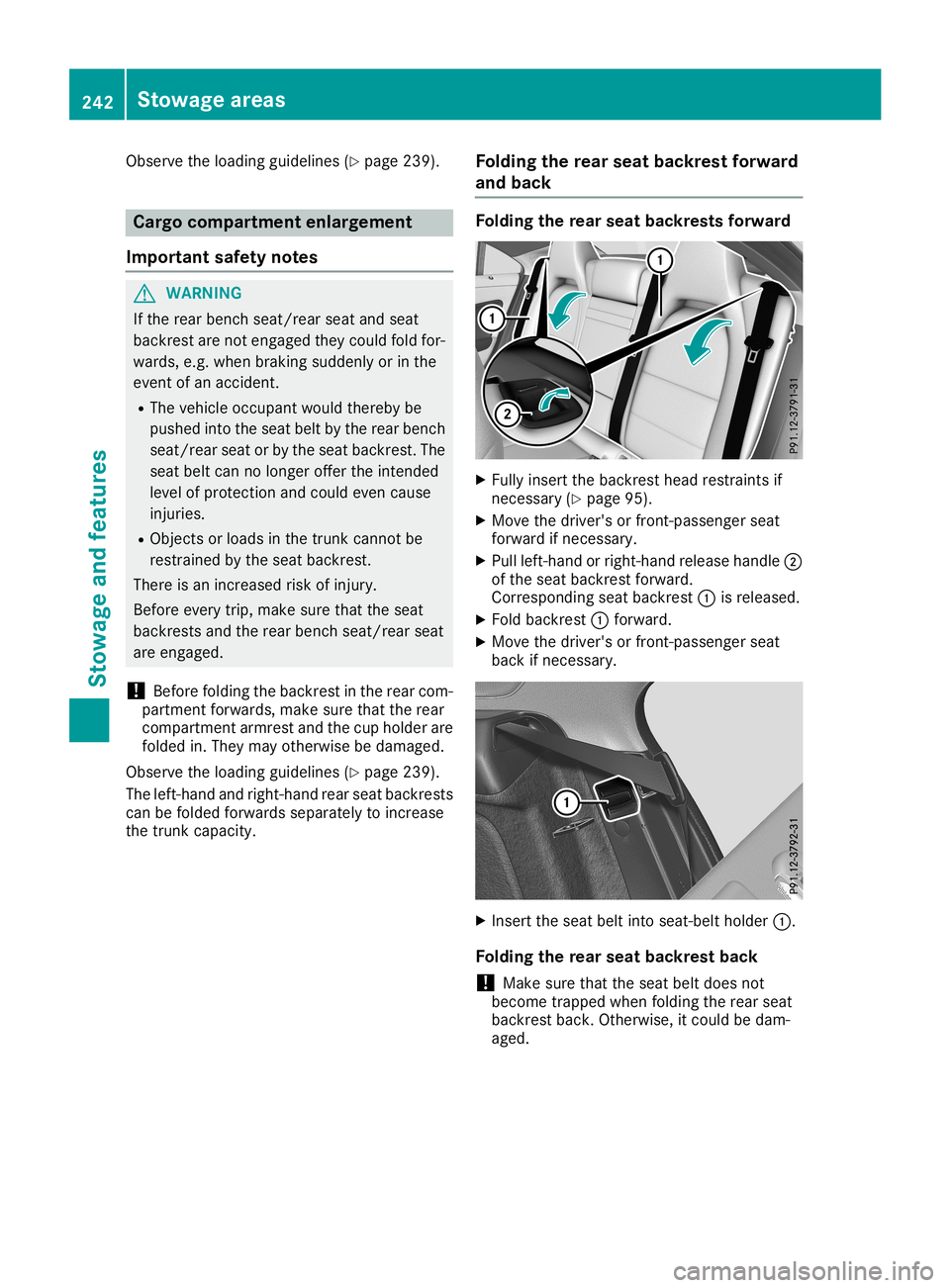
Observe
theloadi ngguide lines(Ypage 239). Cargo
compart mentenlargement
Importa ntsafety notes G
WARNING
If the rear bench seat/rear seatandseat
backrest arenot engaged theycould foldfor-
wards, e.g.when braking suddenly orinthe
event ofan accident.
R The vehicle occupant wouldthereby be
pushed intotheseat beltbythe rear bench
seat/rear seatorby the seat backrest. The
seat beltcannolonger offertheintended
level ofprotection andcould evencause
injuries.
R Objects orloads inthe trunk cannot be
restrained bythe seat backrest.
There isan increased riskofinjury.
Before everytrip,make surethattheseat
backrests andtherear bench seat/rear seat
are engaged.
! Before
folding thebackrest inthe rear com-
partment forwards, makesurethattherear
compartment armrestandthecup holder are
folded in.They mayotherwise bedamaged .
Observe theloadi ngguide lines(Ypage 239).
The left-hand andright-hand rearseat backrests
can befolded forwards separately toincrease
the trunk capacity. Fol
ding therear seat backrest forward
and back Foldin
gthe rear seat backrests forward X
Fully insert thebackrest headrestraints if
necessary (Ypage 95).
X Move thedriver's orfront -passenger seat
forward ifnecessary.
X Pull left-hand orright-hand releasehandle0044
of the seat backrest forward.
Corresponding seatbackrest 0043isreleased .
X Fold backrest 0043forward.
X Move thedriver's orfront -passenger seat
back ifnecessary. X
Insert theseat beltinto seat-belt holder0043.
Foldin gthe rear seat backrest back
! Make
surethattheseat beltdoes not
become trappedwhenfolding therear seat
backrest back.Otherwise, itcould bedam-
aged. 242
Stowage
areasStowage andfeatur es
Page 247 of 330
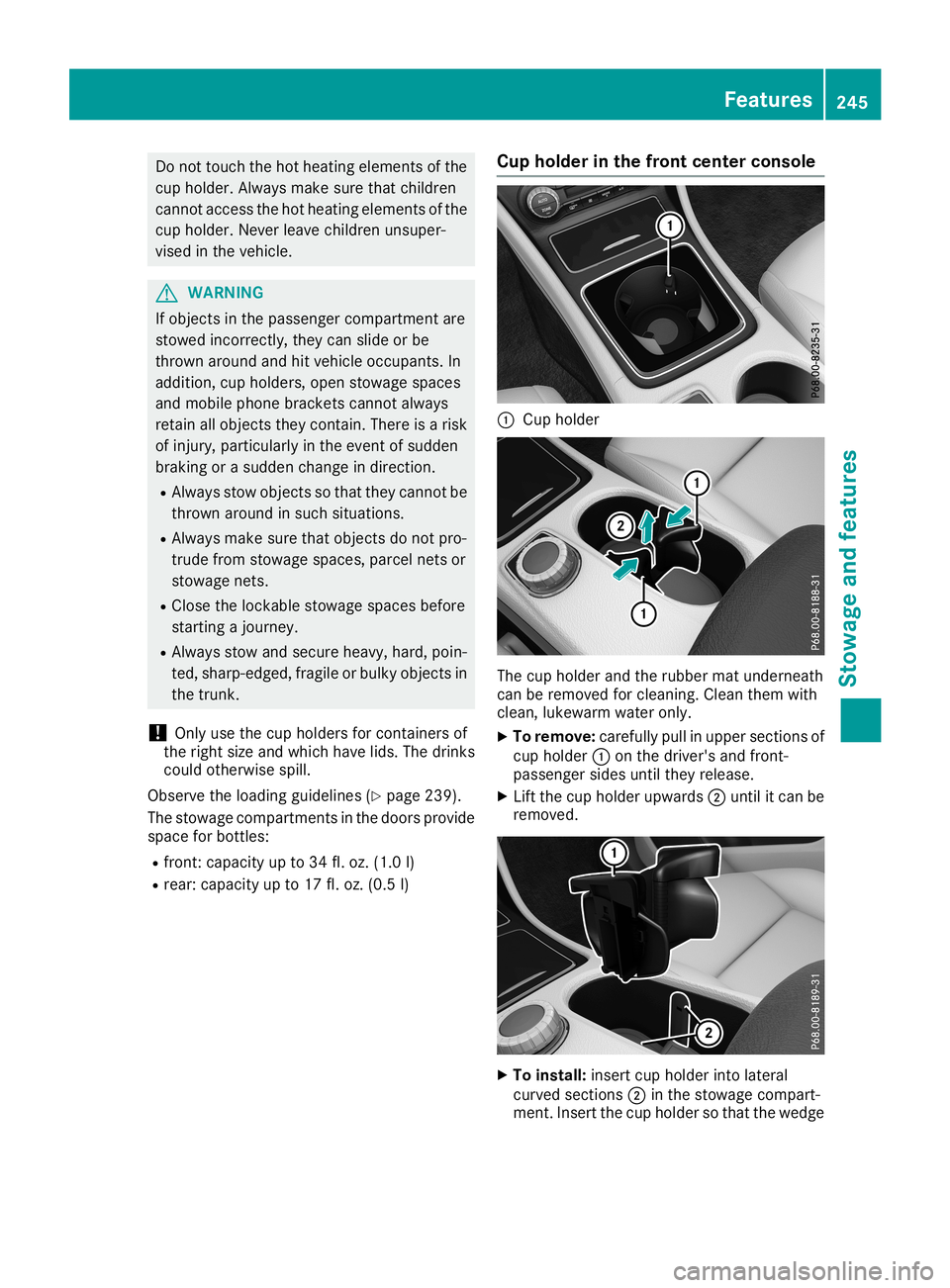
Do
not touchthe hot heati ng eleme ntsofthe
cup holder.Alw aysma kesure tha tchi ldren
canno tacc ess thehot heati ng eleme ntsofthe
cup holder.Nev erleav echi ldren unsuper-
vis ed inthe vehicle. G
WA
RNING
If ob jects inthe passe nge rcomp artment are
stow edinco rrectly ,the ycan slid e or be
thro wnarou nd and hitveh icleoccu pants. In
ad ditio n,cup holders, open stow agesp ace s
and mob ile ph one brackets canno tal wa ys
reta inallob jects theyconta in.The reisaris k
of inju ry,pa rtic ular ly in the eventofsudd en
bra king orasu dd en cha nge indirecti on.
R Alw aysstow objects sotha tthe ycanno tbe
thro wnarou nd insuch situa tions.
R Alw aysma kesure tha tob jects donot pro-
tru de fromstow agesp ace s,pa rcel nets or
stow agenets .
R Close thelockab lestow agesp ace sbe for e
sta rtin gajou rney .
R Alw aysstow andsecurehe avy, ha rd, poin-
ted ,sha rp-e dged ,fra gile or bulky objects in
the trunk.
! Onl
yus ethe cup holders for conta inersof
the right size and which have lids .The drinks
cou ldothe rwise sp ill.
Ob ser vethe load ing guideline s(Y page 239 ).
The stow agecomp artments inthe doors provide
sp ace forbottle s:
R fro nt: cap acityup to34 fl.oz. (1.0 l)
R rear: capacityupto17 fl.oz. (0.5 l) Cup
holde rin the front center conso le 0043
Cuphold er The
cup hold erand therubb ermat undernea th
can beremoved forclea ning. Cleanthem with
clea n,lukew armwater only.
X To remove: carefullypul lin upp ersections of
cup hold er0043 onthe driver' sand front-
pass enger sidesuntil theyrelea se.
X Lift the cup hold erupw ards 0044until itcan be
removed . X
To install :insert cuphold erinto latera l
curved sections 0044inthe stowa gecompart-
ment. Insertthecup hold erso that thewed ge Fe
atures
245Stowageand features Z
Page 277 of 330
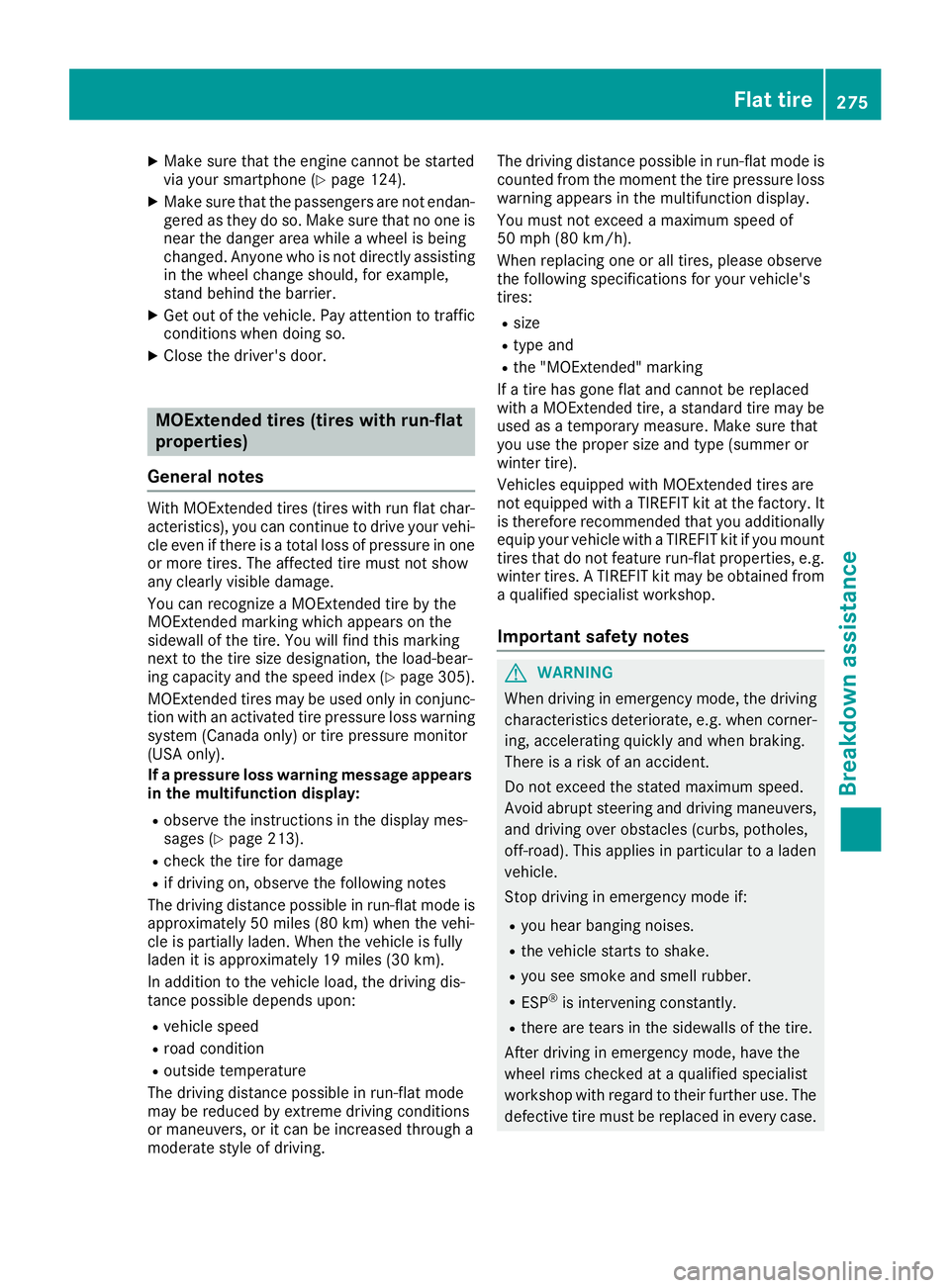
X
Make surethattheengine cannot bestarted
via your smartphone (Ypage 124).
X Make surethatthepassengers arenot endan-
gered asthey doso. Make surethatnoone is
near thedanger areawhile awheel isbeing
changed. Anyonewhoisnot directly assisting
in the wheel change should,forexample,
stand behind thebarrier.
X Get outofthe vehicle. Payattent iontotraffic
condition swhen doing so.
X Close thedriver's door. MOExtended
tires(tires withrun-flat
proper ties)
General notes With
MOExt ended tires(tires withrunflatchar-
acteristics ),you can cont inue todrive yourvehi-
cle even ifthere isatotal lossofpressure inone
or more tires.Theaffected tiremust notshow
any clearly visibledamage.
You canrecogniz eaMOExt ended tirebythe
MOExt ended marking whichappears onthe
sidewa llof the tire. Youwillfind thismarking
next tothe tire size designation, theload-bear-
ing capacity andthespeed index(Ypage 305).
MOExt ended tiresmaybeused onlyinconj unc-
tion with anactivated tirepressure losswarning
system (Canada only)ortire pressure monitor
(USA only).
If apressur eloss warning message appears
in the multifu nctiondisplay:
R observe theinstruct ionsinthe display mes-
sages (Ypage 213).
R check thetire fordamage
R ifdriving on,observe thefollowing notes
The driving distance possibleinrun-flat modeis
approximately 50miles (80km) when thevehi-
cle ispartially laden.Whenthevehicle isfully
laden itis approximately 19miles (30km).
In addition tothe vehicle load,thedriving dis-
tance possible depends upon:
R vehicle speed
R road condition
R outside temperature
The driving distance possibleinrun-flat mode
may bereduced byextrem edriving condition s
or maneuvers, oritcan beincreased througha
moderate styleofdriving. The
driving distance possibleinrun-flat modeis
counted fromthemoment thetire pressure loss
warning appears inthe multifunction display.
You must notexceed amaximum speedof
50 mph (80km/h).
When replacing oneorall tires, please observe
the following specifications foryour vehicle's
tires:
R size
R type and
R the "MOExt ended" marking
If atire has gone flatand cannot bereplaced
with aMOExt ended tire,astandard tiremay be
used asatemporary measure.Makesurethat
you usetheproper sizeandtype (summer or
winter tire).
Vehicles equippedwith MOExt ended tiresare
not equipp edwith aTIREFIT kitatthe factory. It
is therefore recommen dedthat youadditionally
equip yourvehicle withaTIREFIT kitifyou mount
tires thatdonot feature run-flat properties, e.g.
winter tires.ATIREFIT kitmay beobtained from
a qual ified specialist workshop.
Import antsafety notes G
WARNING
When driving inemergency mode,thedriving
characterist icsdeteriorate, e.g.when corner-
ing, accelerating quicklyandwhen braking.
There isarisk ofan accident.
Do not exceed thestated maximum speed.
Avoid abrupt steering anddriving maneuvers,
and driving overobstacles (curbs,potholes,
off-road). Thisappli esinparticular toaladen
vehicle.
Stop driving inemergency modeif:
R you hear banging noises.
R the vehicle startstoshake.
R you seesmoke andsmell rubber.
R ESP ®
is interven ingconst antly.
R there aretears inthe sidewa llsofthe tire.
Aft erdriving inemergency mode,havethe
wheel rimscheck edataqual ified specialist
workshop withregard totheir further use.The
defective tiremust bereplaced inevery case. Flat
tire
275Breakdown assistance Z
Page 307 of 330

Observe
thelegal lyrequired minimum tiretread
depth (Ypage 291). Winter tirescanreduce the
braking distance onsnow-covered surfacesin
comparison withsummer tires.Thebraking dis-
tance isstill much further thanonsurfaces that
are not icyorcovered withsnow. Takeappro-
priate carewhen driving.
Further information onwinter tires(M+S tires)
(Y page 292).
Temper ature G
WARNING
The temperature gradeforthis tireisestab-
lished foratire that isproperly inflatedand
not overloaded .Exc essive speed, underinfla-
tion, orexcessive loading,either separately or
in combination, cancause excessive heat
buil d-up andpossible tirefailu re.
The temperature gradesareA(the highest), B,
and C,representing thetire's resistance tothe
generation ofheat anditsabil itytodissipa te
heat when tested undercontrolled conditions
on aspecified indoorlaboratorytestwheel. Sus-
tained hightemperature cancause thematerial
of the tire todegenerate andreduce tirelife, and
excessive temperature canlead tosudden tire
failu re.The grade Ccorresponds toalevel of
performance whichallpassenger cartires must
meet under theFederal MotorVehicle Safety
Standard No.109. Grades Band Arepresent
higher levelsofperformance onthe labora tory
test wheel thantheminimum requiredbylaw. Tire
labeli ng
Overview 0043
Uniform TireQuali tyGradi ngStandards
(Y page 309)
0044 Department ofTransportation, TireIdentifi-
cation Number (Ypage 308)
0087 Maximum loadrating (Ypage 307)
0085 Maximum tirepressures (Ypage 296)
0083 Manufacturer
0084 Tire material (Ypage 308)
006B Tire size designation, load-bearingcapacity
and speed rating(Ypage 305)
006C Load index (Ypage 307)
006D Tire name
The markings described aboveareonthe tire in
addition tothe tire name (sales designation) and
the manufacturer's name.
i Tire
data isvehicle-specific andmay deviate
from thedata inthe example.
Tire size designation, load-bearing
capacity andspeed rating G
WARNING
Exc eeding thestated tireload-bea ringcapa-
city and theapproved maximum speedcould
lead totire damage orthe tire bursting. There
is arisk ofaccident.
Therefore, onlyusetiretypes andsizes
approved foryour vehicle model.Observe the All
about wheelsand tires
305Wheels andtires
Z
Page 308 of 330
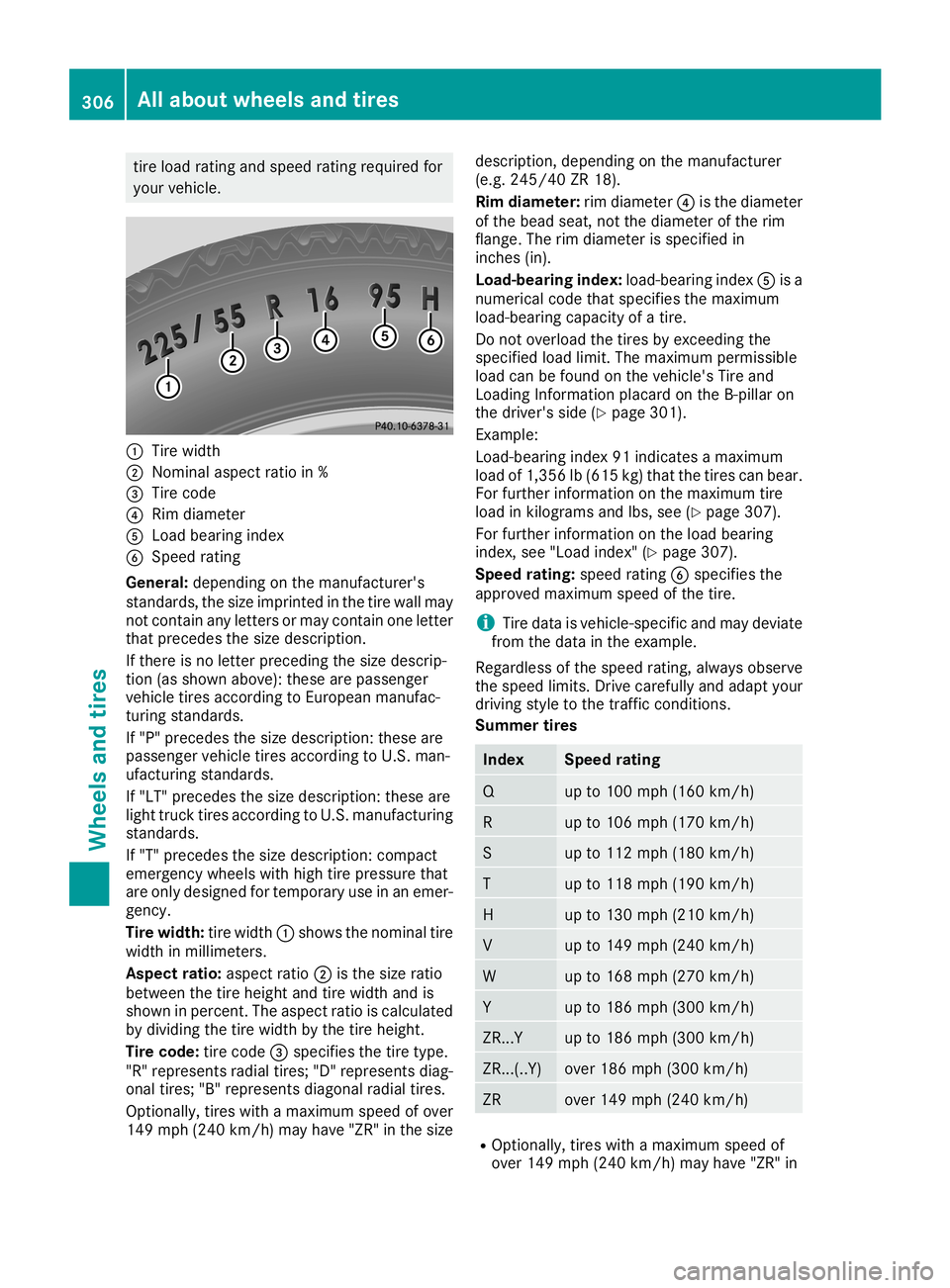
tire
load rating andspee dra ting required for
yo ur veh icle. 0043
Tire width
0044 Nom inalas pe ct ratio in%
0087 Tire cod e
0085 Rim diam ete r
0083 Loadbe aring index
0084 Spe edrating
Ge neral: dependi ng on the manuf actu rer's
sta nda rds,the size impri nted inthe tire wallma y
not conta inany letters orma yconta inone letter
tha tpre ced esthe size descri ption.
If the reisno letter preced ingthe size descri p-
tio n(a ssho wnabove ):the searepa sse nge r
veh icletire sacc ording toEur opeanma nuf ac-
tur ing standa rds.
If "P "pre ced esthe size descri ption: theseare
pa sse nge rveh icletire sacc ording toU.S. man-
uf actu ringsta nda rds.
If "L T" pre ced esthe size descri ption: theseare
li ght trucktire sacc ording toU.S. manuf actu ring
sta nda rds.
If "T "pre ced esthe size descri ption: comp act
eme rgency wheelswith high tire pressu retha t
ar eonl yde signe dfor temp oraryusein an eme r-
ge ncy .
Tire width: tirewidth 0043sho wsthe nomi naltire
wi dth inmi llim ete rs.
As pec tratio :as pe ct ratio 0044 isthe size ratio
be twe enthe tire height and tirewidth and is
sho wninpe rcen t.The aspe ctratio iscal cul ate d
by divid ing the tire width bythe tire height.
Tire code: tire code0087 speci fiesthe tire type.
"R "rep resents radial tire s;"D" represents diag -
ona ltire s;"B" represents diag ona lra dial tire s.
Op tional ly,tire swi th ama xim um spee dof ove r
149 mph (240 km/h )ma yha ve "ZR" inthe size de
scri ption, dependi ng on the manuf actu rer
(e .g. 245/4 0ZR 18) .
Rim diamete r:rim diam ete r0085 isthe diam ete r
of the bead seat, not thediam ete rof the rim
fla nge .Th erim diam ete ris sp eci fiedin
inch es(in).
Lo ad-b earingin dex :lo ad -be aring index0083 isa
num erical cod etha tsp eci fiesthe maxim um
lo ad -be aring capacityof atire .
Do not overload the tiresby exce eding the
sp eci fiedload limi t.Th ema xim um permi ssible
lo ad can befou ndonthe vehicle'sTire and
Loa ding Info rma tionplaca rdon the B-pi llar on
the driver 'sside (Ypage 301) .
Exam ple:
Loa d-bearin gind ex91 indicates ama xim um
lo ad of1,3 56lb(61 5kg )tha tthe tirescan bear.
For furthe rinf orm ation onthe maxim um tire
lo ad inkilog rams and lbs, see(Y page 307 ).
For furthe rinf orm ation onthe load bearing
ind ex, see"L oa dind ex" (Ypage 307 ).
Spe edratin g:spee dra ting 0084speci fiesthe
ap pro ved maxim um spee dof the tire.
i Ti
re dataisveh icle-s pecificand mayde via te
fro mthe data inthe exampl e.
Re gardl essof the spee dra ting ,al wa ysobserve
the spee dlimi ts. Drivecar efully and adaptyo ur
dri vin gsty leto the trafficcond itions .
Summe rtire s In
dex Spe
edratin g Q up
to100 mph (160km/h ) R up
to106 mph (170km/h ) S up
to112 mph (180km/h ) T up
to118 mph (190km/h ) H up
to130 mph (210km/h ) V up
to149 mph (240km/h ) W up
to168 mph (270km/h ) Y up
to186 mph (300km/h ) ZR
...Y up
to186 mph (300km/h ) ZR
...(. .Y) ove
r186 mph (300 km/h ) ZR ove
r149 mph (240 km/h ) R
Op tional ly,tire swi th ama xim um spee dof
ove r149 mph (240km/h )ma yha ve "ZR" in 30
6 Al
labo utwhee lsan dtire sWhe elsand tires
Page 311 of 330
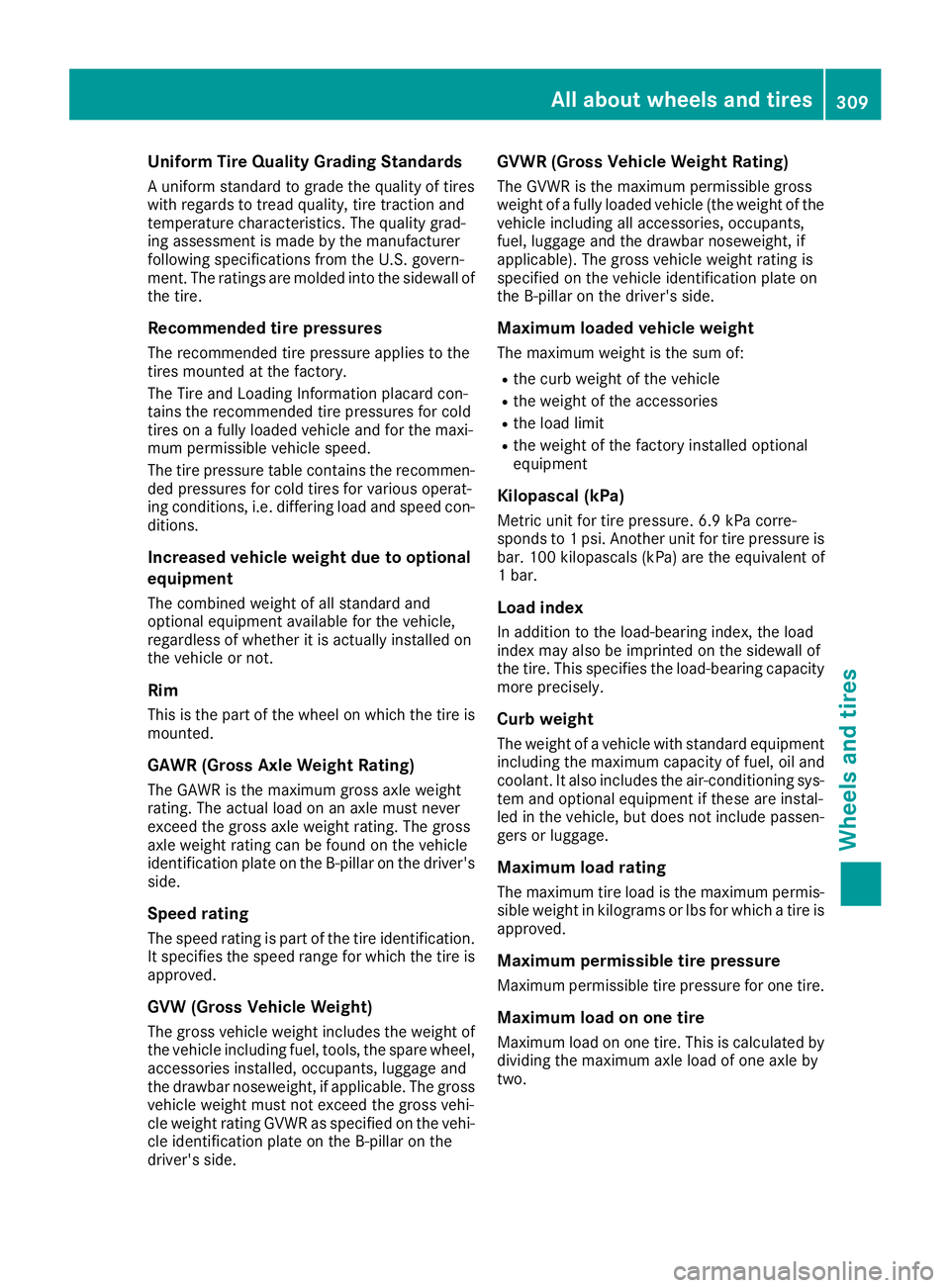
Uniform
TireQualit yGra ding Standar ds
A unifor mstan dard tograde thequality oftires
with regards totread quality, tiretraction and
tempe rature charac teristics.The quality grad-
ing assessmen tis made bythe manufac turer
following specificationsfrom theU.S.govern -
ment .The ratin gsare molded intothe sidewall of
the tire.
Recomm endedtirepr essures
The recom mended tirepressure appliestothe
tires mount edatthe factory.
The Tire andLoading Informat ionplacard con-
tains therecom mended tirepressures forcold
tires onafully loaded vehicle andforthe maxi-
mum permissible vehiclespeed.
The tirepressure tablecontains therecom men-
ded pressures forcold tires forvarious operat-
ing con dition s,i.e. differin gload andspeed con-
dition s.
Increased vehicleweightduetooptiona l
equip ment
The combin edweight ofall stan dard and
option alequipment availableforthe vehicle,
regardless ofwhether itis actually installed on
the vehicle ornot .
Rim
This isthe part ofthe wheel onwhich thetire is
mount ed.
GAWR (Gross AxleWeight Rating)
The GAWR isthe maximum grossaxleweight
ratin g.The actual loadonanaxle must never
exc eed thegross axleweight rating.The gross
axle weight ratingcan befound onthe vehicle
ident ificationplate onthe B-pillar onthe driver' s
side.
Speed rating
The speed ratingis part ofthe tire ident ification.
It specifies thespeed rangeforwhich thetire is
approved.
GVW (Gross Vehicle Weight)
The gross vehicle weightincludes theweight of
the vehicle includin gfuel, tools, thespare wheel,
access oriesinstalled, occupants, luggage and
the drawbar noseweight ,if applicable. Thegross
vehicle weightmustnotexceed thegross vehi-
cle weight ratingGVWR asspecified onthe vehi-
cle ident ificationplate onthe B-pillar onthe
driver' sside. GVW
R(Gross Vehicle WeightRating)
The GVWR isthe maximum permissible gross
weight ofafully loaded vehicle (theweight ofthe
vehicle includin gall acces sories, occupants,
fuel, luggage andthedrawbar noseweight ,if
applicable). Thegross vehicle weightratingis
specified onthe vehicle identificationplate on
the B-pillar onthe driver' sside.
Maxim umloaded vehicle weight
The maximum weightisthe sum of:
R the curb weight ofthe vehicle
R the weight ofthe acces sories
R the load limit
R the weight ofthe factoryinstalled option al
equipment
Kilopascal (kPa)
Metr icunit fortire pressure. 6.9kPa corre-
sponds to1psi. Another unitfortire pressure is
bar. 100 kilopasc als(kPa) arethe equivalent of
1 bar.
Load index
In addition tothe load-bearin gindex ,the load
index mayalsobeimprin tedonthe sidewall of
the tire. This specifies theload-bearin gcapacit y
more precise ly.
Curb weight
The weight ofavehicle withstandard equipment
includin gthe maximum capacityof fuel, oiland
coolant .It also includes theair-c ondit ioningsys-
tem andoption alequipment ifthese areinstal-
led inthe vehicle, butdoes notinclude passen-
gers orluggage.
Maxim umload rating
The maximum tireload isthe maximum permis-
sible weight inkilogram sor lbs forwhich atire is
approved.
Maxim umperm issible tirepr essure
Maximum permissible tirepressure forone tire.
Maxim umload onone tire
Maximum loadonone tire. This iscalculated by
dividing themaximum axleload ofone axle by
two. All
about wheels andtires
309Wheels andtires Z
Page 314 of 330
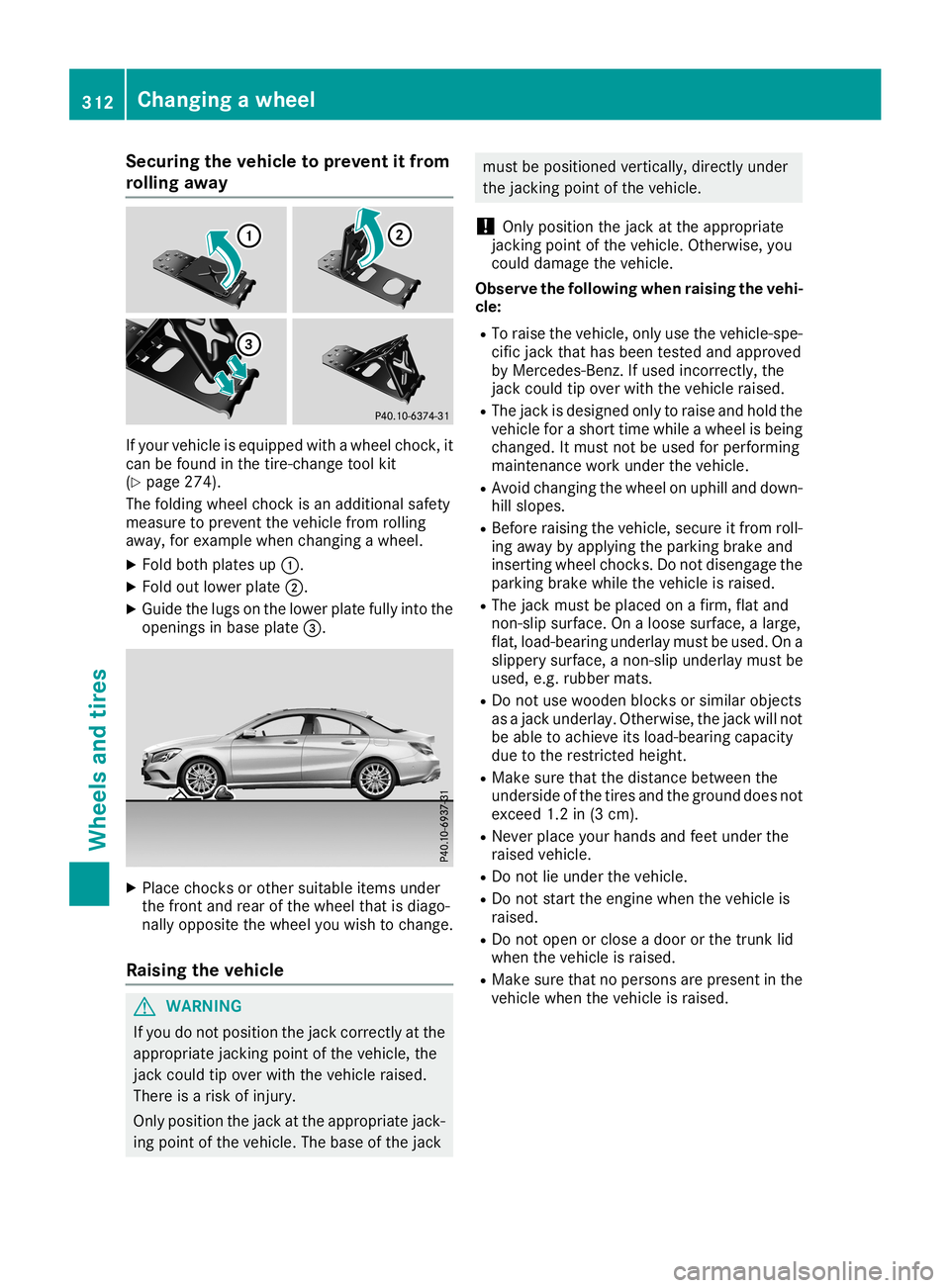
Securing
thevehicle toprevent itfrom
rolling away If
your vehicle isequippe dwith awheel chock,it
can befound inthe tire-c hange toolkit
(Y page 274).
The folding wheelchock isan additional safety
measure toprevent thevehicle fromrolling
away ,for example whenchanging awheel.
X Fold both plates up0043.
X Fold outlower plate0044.
X Guide thelugs onthe lower platefullyintothe
openings inbase plate 0087. X
Place chocksor other suitable itemsunder
the front andrear ofthe wheel thatisdiago-
nally opposite thewheel youwish tochange.
Raising thevehicle G
WARNING
If you donot position thejack correct lyat the
appropriate jackingpoint ofthe vehicle, the
jack could tipover withthevehicle raised.
There isarisk ofinjury.
Only position thejack atthe appropriate jack-
ing point ofthe vehicle. Thebase ofthe jack must
bepositioned vertically,directlyunder
the jackin gpoint ofthe vehicle.
! Only
position thejack atthe appropriate
jackin gpoint ofthe vehicle. Otherwise, you
could damage thevehicle.
Observe thefollow ingwhen raising thevehi-
cle:
R To raise thevehicle, onlyusethevehicle-spe-
cific jack thathasbeen tested andapproved
by Mercedes-B enz.Ifused incorrec tly,the
jack could tipover withthevehicle raised.
R The jack isdesigned onlytoraise andhold the
vehicle forashort timewhile awheel isbeing
changed. Itmust notbeused forperforming
maintenan cework under thevehicle.
R Avoid changing thewheel onuphill anddown-
hill slopes.
R Before raising thevehicle, secureitfrom roll-
ing away byapply ingthe parking brakeand
insertin gwheel chocks.Do not disengage the
parking brakewhilethevehicle israised.
R The jack must beplaced onafirm, flatand
non- slipsurface. Onaloose surface, alarge,
flat, load-bearing underlaymustbeused. Ona
slippery surface, anon- slipunderlay mustbe
used, e.g.rubber mats.
R Do not use wooden blocksorsimilar objects
as ajack underlay. Otherwise, thejack willnot
be able toachieve itsload-bearing capacity
due tothe restrict edheight.
R Make surethatthedistance between the
underside ofthe tires andtheground doesnot
exceed 1.2in(3 cm).
R Never placeyourhands andfeet under the
raised vehicle.
R Do not lieunder thevehicle.
R Do not start theengine whenthevehicle is
raised.
R Do not open orclose adoor orthe trunk lid
when thevehicle israised.
R Make surethatnopersons arepresent inthe
vehicle whenthevehicle israised. 312
Changing
awheelWheels andtires